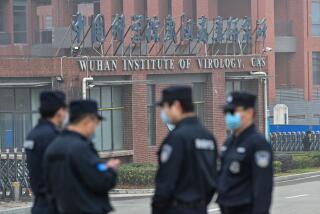X-Ray Laser Test Data Inaccurate, GAO Study Finds
- Share via
Results from tests of the X-ray laser, a key component in the Administration’s Strategic Defense Initiative, contained “inaccuracies,” a recent report by the Government Accounting Office says.
However, in a declassified summary obtained Tuesday by The Times, the GAO denied that the program has been “arbitrarily accelerated” on the basis of the erroneous data.
The tests are part of a series being conducted at the government’s Nevada test site by scientists from the Lawrence Livermore National Laboratory. They hope to focus the power of a nuclear explosion into an X-ray laser strong enough to destroy satellites or missiles in space.
On Nov. 12, 1985, The Times reported that the tests were proceeding even though scientists at Livermore and the government’s other weapons laboratory in Los Alamos, N.M., had warned that measuring equipment used in earlier tests had yielded false results.
This critique was later endorsed by the prestigious Jason Group, a panel of senior scientists with whom the Defense Department consults on projects involving complex technologies. At the time, scientific critics of the program charged that Livermore officials had leaked erroneously optimistic reports of the tests to the media in the hope of securing additional funding.
Those charges were repeated Tuesday by Livermore physicist Hugh E. DeWitt. “The inaccuracies in the tests were large and call into question the optimistic claims for the X-ray laser leaked to the media last spring by the proponents of SDI,” he said.
The GAO found that “absolute power calculation inaccuracies occurred in past tests. . . . Essentially we found the X-ray laser program is a research program with many unresolved issues.”
The report noted that “in our opinion there was no ‘design flaw’ in the diagnostic instrumentation as mentioned in the Times article, however, analysis of test data by Lawrence Livermore National Laboratory scientists raised questions about the accuracy of some experimental data. As a result, some diagnostic equipment was reconfigured. These unexpected measurement uncertainties are now much better understood. In our opinion, there was no need to delay the latest X-ray nuclear test. We also found that the X-ray laser program was not being arbitrarily accelerated.”
More to Read
Sign up for Essential California
The most important California stories and recommendations in your inbox every morning.
You may occasionally receive promotional content from the Los Angeles Times.










